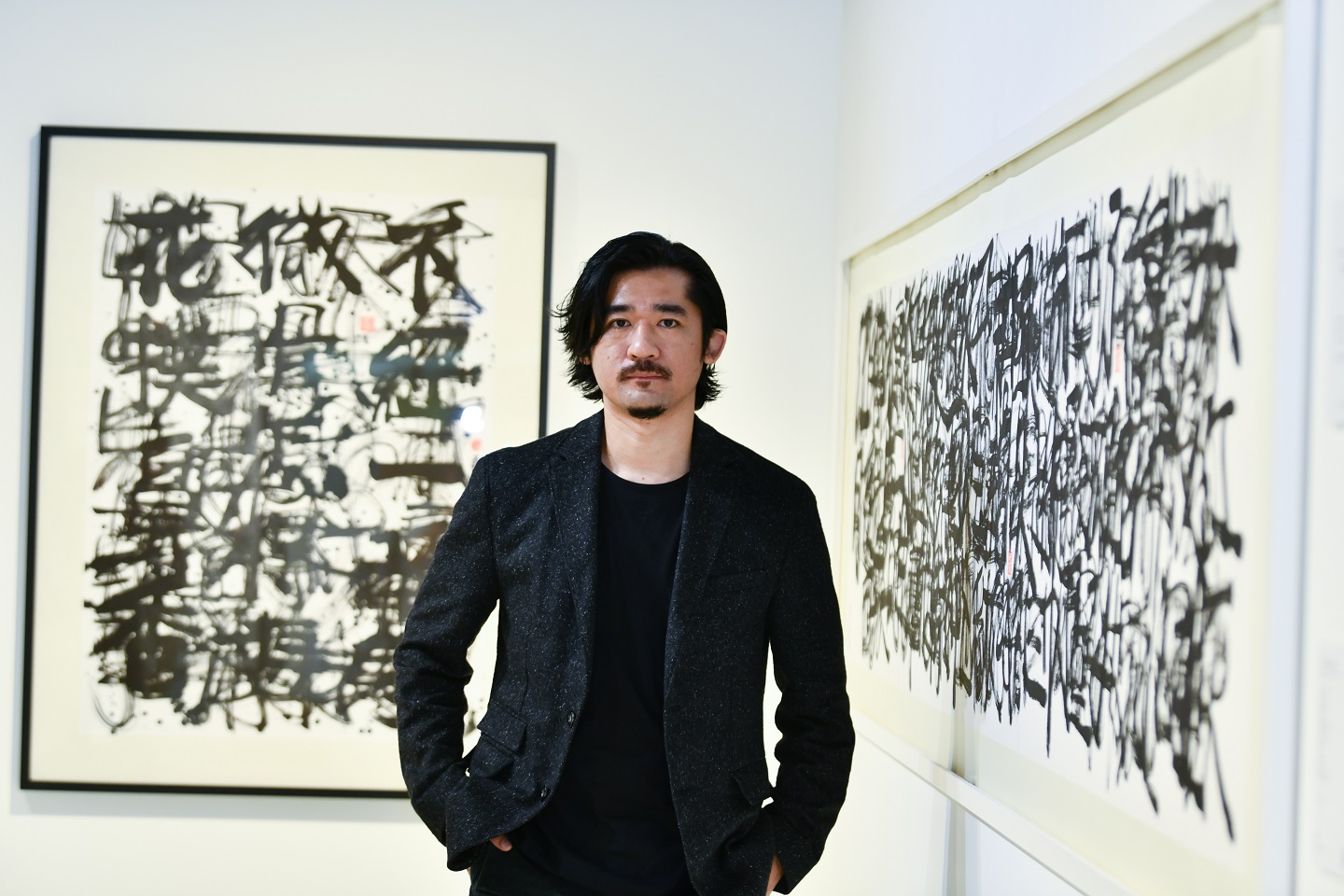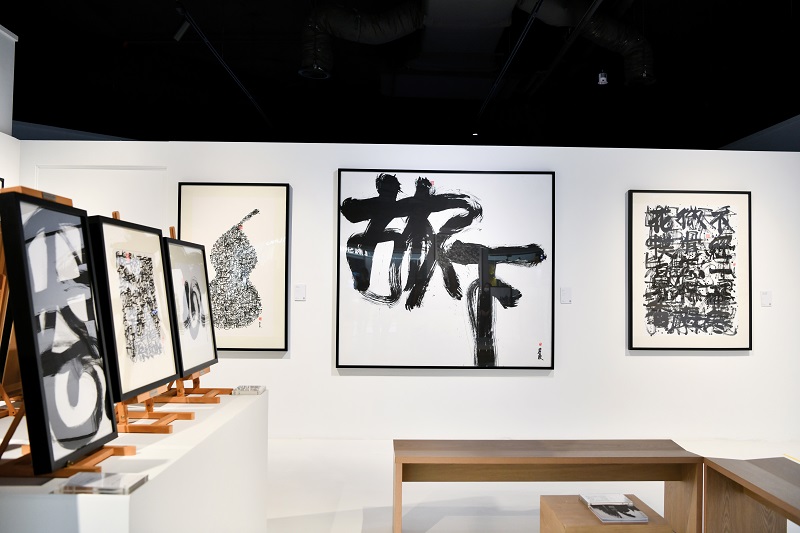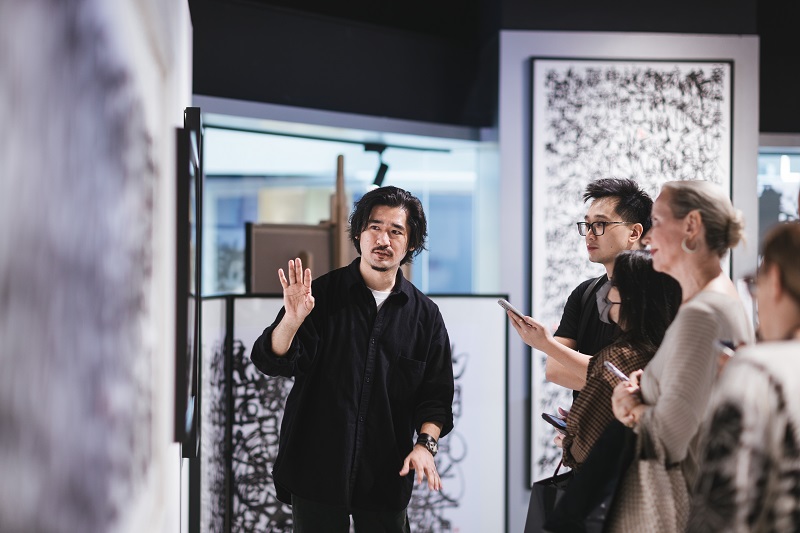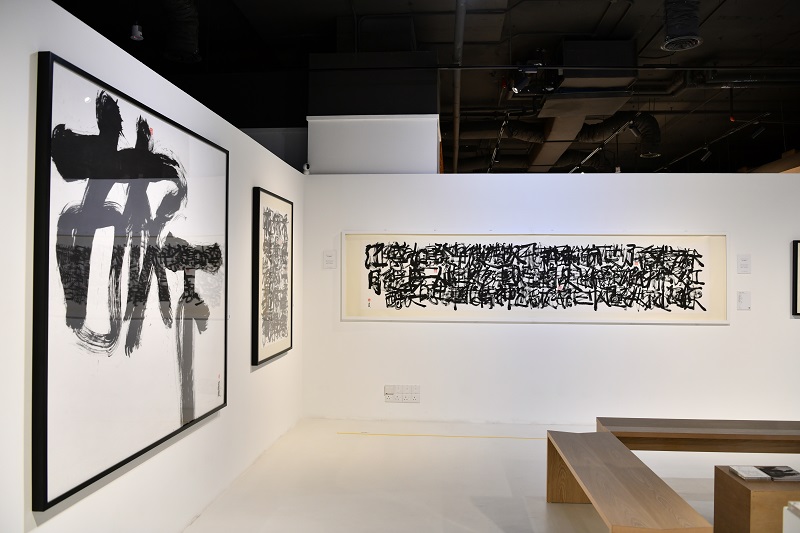
Yap: I hope my work can calm people and bring them back to being present (Photo: Sam Fong/ The Edge Malaysia)
When Jameson Yap, or JY, as he is better known, set out to make arrangements for his solo exhibition Mindfulness at The Starhill’s Eslite Spectrum, he wanted the entryway to be a threshold where troubles could be left behind, a safe space where individuals could detach from the world and give themselves grace, as well as time, to ponder and reflect. It is the reason a lofty centrepiece with the words fang xia (which means “to let go” or “be set free”) hangs from across the ingress.
This artwork, or more precisely, the combination of two specific Chinese characters, sets the tone for the exhibition and speaks eloquently of the enriching experiences the Perlis-born calligrapher has encountered in his pursuit of this ancient artform.
Yap’s journey began when he was just five, under the guidance of his grandfather. “I think one of the reasons he insisted I learn calligraphy was because he believed it would discipline me and build character,” he fondly recalls. Yap spent the better part of his childhood with his grandparents as dad had to travel for business and mum would follow. He and grandpa were particularly close. “I learnt a lot of life values from him.”
Yap began developing his own distinctive style about a decade ago. Being a traditional art form, Chinese calligraphy came with its own set of rules as well as limits. “I know my style and character. I’m free and daring. But when I do calligraphy, I’m like another person.” Wanting to do things differently, enlightenment soon came in the unlikely form of a National Geographic TV programme. “I was watching a documentary about the Amazon River. Close-up and bird’s-eye-view shots of nature abounded, and I kind of linked it all to a book I read earlier about Bruce Lee’s relationship with water.
“I wanted freedom within [calligraphy]. So I got inspired and wondered what if I did things differently.”
20230612_peo_jameson_yap_8_sam.jpg

Yap went all out, breaking every conventional rule associated with calligraphy, even going as far as writing the strokes in reverse. He was drawn to the undulating flow of water and eventually developed a style he calls liu su or River Stroke, where a character is completed in a single continuous brush stroke. He also started overlapping characters and filling out the paper to its edges — a big no-no by traditional standards — to elicit more powerful effects.
Purists may shudder, but Yap has always been open to conversation. “In the end, our intentions are the same. We just want to promote the ancient art to a wider audience and get more people interested.” He has this to say to the traditionalists: “If it is your first time encountering my work, don’t judge me quickly. Give me a bit of space and time.”
It may also come as a surprise to discover that almost half of Yap’s collectors cannot read Chinese. The artist shrugs, saying it is interesting to see people “feel” the artworks and be impacted by the energy first before understanding their meaning. Putting heart before head allows one to come with a “pure” mind willing to be moved by art, rather than resolute expectations. Again, it is all about being formless like water and open to change.
That said, there are some elements in the practice Yap believes cannot be compromised, namely the tools out of which Chinese calligraphy was born. The brush, ink, paper and inkstone are all vital implements — the four treasures, if you will — that give life to the art. The relationship between them is inseparable. Once the ink marks the xuan (rice) paper, even water would not be able to lift it. On the other hand, water is required to produce ink in the right consistency. Yap reveals that he even specifically collects water from the mountains for this purpose. A regular at the Templer Park trails, the hiker does so to “borrow” energy from nature.
har56297.jpg

“I believe in energy. With mountain water, it feels like even nature is helping me. When I base my art on an ancient poem, history helps me. I’m just a medium to create. Therefore, my works are not 100% mine, it’s also from these other elements. Some people say my work contains energy. I think it all goes back to that.”
Chinese calligraphy is difficult to master. “It’s not like painting which you can still change with layers of colours,” he says. “For this, you get one chance. I can’t have any doubt or it will show in my strokes. I need to be prepared in my subconscious. The environment has to be still. No air cond, no fan and it has to be warm. These are things I insist on to be at my best.” Prior to that, there is also a lot of research involved. He takes time to dwell on the characters, putting himself in the place of the poets or the protagonists of ancient stories.
Yap did so with the poem nian nu qiao (or Remembrance of the Tale of the Crimson Cliff) by Su Shi, one of the most revered poets and political figures from the Song Dynasty. The poem reminisces about times of war during the period of the Three Kingdoms. Coupled with his River Stroke technique, Yap presents it with overlapping characters to create a 3.5m artwork that evokes the feeling of wistful nostalgia, replicating the effects of a distant memory being slightly different each time one revisits it. Some words may pop up at first glance, but viewers may discover other characters the next time they lay eyes on it.
Depending on his preparation, Yap can sometimes complete a piece at once. This was the case with fang xia. It came out different from the initial draft, but the outcome felt right. “I picked the big brush that I hadn’t used for a long time. I think the brush was very happy, which is why I was so confident,” he quips. He noticed people would sit in front of this painting for a long time and messages from fans have been received, thanking him for giving them a cathartic moment. Art has a beautiful way of touching hearts, he expresses. Catharsis was not his main intention when creating the piece, however. The strong strokes were indicative of the courage to let go of one’s comfort zone, being brave and stepping out.
20230612_peo_jameson_yap_9_sam.jpg

At his level, Yap feels he has more freedom to explore different things and realises the influence he wields. It is one of the reasons his artworks always bear positive and encouraging messages, inspired by life, family, nature and love. The father of three, with another on the way, says his relationship with calligraphy is two-way: “I cannot live without it. It’s in me. At this point, maybe it’s in my blood.”
If there was one message he could send out to people seeing his art for the first time, it would be “to feel”. He explains: “The world has too much noise. We no longer respect or are honest with our own feelings. I hope my work can calm people and bring them back to being present. If you walk out a little more healed, whether it’s 1% or 10%, I’ve already served my purpose. That is why I curated these pieces.”
Practising calligraphy is one of the few ways that allow Yap to feel close to his grandfather since his passing. At the exhibition, the artist looks around the room filled with works he has created over the years and softly confesses that his calligraphy personifies his grandfather. He recalls many lessons learnt from the great man, who kept a journal to pen down personal thoughts throughout his life. In his diary, now in Yap’s possession, is a line that this filial grandson will always remember: Mang er bu mang, mang er bu fan. “It means, ‘You can be very busy, but you are not blinded. You can be very busy, but not get frustrated.’ These words gave me a lot of calmness and taught me to always have the right mindset.”
'Mindfulness' is held from 10am to 10pm daily at Eslite Spectrum, The Starhill KL, until July 2.
This article first appeared on June 19, 2023 in The Edge Malaysia.


